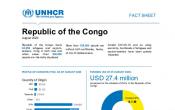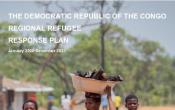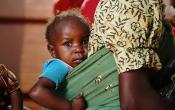Republic of the Congo
Operation: Republic of the Congo
Location
{"longitude":16,"latitude":0,"zoom_level":0,"iso_codes":"'COG'"}
By clicking on the icons on the map, additional information is displayed.
The boundaries and names shown and the designations used on this map do not imply official endorsement or acceptance by the United Nations.
Key Figures
| 2019 year-end results | |
| 2,000 | emergency shelters were provided for asylum-seekers from the DRC |
| 75% | 75% of IDP households in the south-east received core relief items, providing assistance to some 5,600 individuals |
| 2020 planning figures | |
| 100% | of people of concern will be individually registered |
| 100% | of people of concern with intention to return have returned voluntarily, in safety and dignity |
| 80% | of people of concern have access to primary health care |
| 76% | of primary school-aged children will be enrolled in primary education |
| 45% | of people of concern will have own business or be self-employed for more than 12 months |
Latest Updates and Related Links
People of Concern
3%
Decrease in
2019
2019
| 2019 | 191,605 |
| 2018 | 197,095 |
| 2017 | 167,303 |

[["Refugees",25670],["Asylum-seekers",14416],["IDPs",134430],["Returned IDPs",5312],["Returned refugees",4],["Others of concern",11773]]
Loading ...
Republic of the Congo
< Back
2019
{"categories":[2015,2016,2017,2018,2019,2020],"budget":[35.34159306,32.00000031,28.642667151999998,23.57916797,26.86898516,29.406637869999997],"expenditure":[10.261615,9.33211215,12.211981540000002,11.781663009999999,13.10641082,null]}
{"categories":[2015,2016,2017,2018,2019,2020],"p1":[35.34159306,32.00000031,26.232864151999998,20.40916797,23.46016411,25.94064166],"p2":[null,null,null,null,1.250599,1.1549573999999998],"p3":[null,null,null,null,null,null],"p4":[null,null,2.409803,3.17,2.15822205,2.31103881]}
{"categories":[2015,2016,2017,2018,2019,2020],"p1":[10.261615,9.33211215,9.834634470000001,8.8974485,12.232459689999999,null],"p2":[null,null,null,null,0.36930890000000005,null],"p3":[null,null,null,null,null,null],"p4":[null,null,2.37734707,2.8842145099999996,0.50464223,null]}
Loading ...
CHOOSE A YEAR
- 2014
- 2015
- 2016
- 2017
- 2018
- 2019
- 2020
Operational context
Although the security situation remained calm, access to essential services, such as health care and education, remained a considerable challenge due to their lack of resources, staff and capacity.Following a civil registration census in 2019, it was identified that over 118,000 people born in the Republic of the Congo (Congo) were without birth certificates. The number of people at risk of statelessness was increasing.
The IDP situation in the Pool was stabilizing, with returns taking place in the department since 2018. Through its involvement in the Peacebuilding Fund project, UNHCR provided shelter and livelihood kits to returnees and former combatants. UNHCR also distributed core relief items to IDPs and returnees. Conversely, a second IDPs situation began in the last quarter of 2019, with flooding affecting Likouala, Plateau and Cuvette regions. An estimated 170,000 people were affected. UNHCR mobilized core relief items to support 150 households in Likouala.
Population trends
At the end of 2019, the Congo was host to some 25,700 refugees and 14,400 asylum-seekers. More than 6,200 refugees, mainly from the Central African Republic (CAR) chose to return to their country of origin. A tripartite agreement to facilitate the voluntary repatriation of Central African refugees was signed between UNHCR, the Congo, and the CAR in August 2019. Some 9,700 asylum-seekers were registered in 2019 (including 8,800 who arrived from the Democratic Republic of the Congo (DRC) in December 2018).Over 300,000 people were internally displaced in the Congo, including some 170,000 people who were displaced as a result of flooding in October. There were still some 134,400 IDPs in the south-east as a result of previous conflict, with returns ongoing.
Achievements
- Refugees were included in World Bank programmes alongside host communities to support their access to social protection, agricultural projects and health and education services.
- The Government adopted a national action plan on statelessness.
- A tripartite agreement was signed between UNHCR, the Congo and the CAR in August 2019 to facilitate the voluntary repatriation of refugees from the CAR.
Unmet needs
- The voluntary repatriation operation for DRC refugees was critically underfunded. Indeed, the office was able to prioritize only 1% of the overall needs. With this funding shortage the Office was not able to support voluntary repatriation for 5,000 refugees and asylum-seekers who had expressed their willingness to return to the DRC.
- Livelihood opportunities were required for 30,000 refugees and asylum-seekers who were dependent on food assistance.
- A lack of funding inhibited essential protection monitoring and response needed to assist people displaced as a result of flooding in late 2019.
Working environment
With no elections scheduled for 2019 and the ceasefire agreement signed in December 2017 between the Government and the armed groups in the Pool region, the political landscape in the Republic of the Congo is expected to remain calm. These developments have given way to the development and roll-out of a disarmament, demobilization and reintegration (DDR) process.The security context may also remain stable following the implementation of police and army restructuration measures, which began in 2018. This will enable UNHCR to carry out its activities without any hindrance. However, access to the Pool region continues to be restricted for UN staff, requiring approval by the Ministry of Defence. Furthermore, the delivery of humanitarian assistance and inclusion of refugees and others of concern in the social services is hampered by the challenging economy.
The Republic of the Congo reviewed its 2018-2021 National Development Plan last year and UNHCR was involved in the discussions. UNHCR also actively participates in UNDAF thematic groups on social protection and education. UNHCR will also continue to build partnership with UN agencies and other stakeholders as well as advocate for the inclusion of refugees into UNDAF and WB IDA 2018.
The population planning figures for 2019 are close to 93,500 IDPs, some 29,700 refugees from the Central African Republic, 16,500 refugees and asylum-seekers from the Democratic Republic of the Congo, and a further 1,100 refugees and asylum-seekers of various nationalities. Majority of the people of concern reside in urban areas. The change in planning figures is impacted by the cessation clause for Rwandan refugees, which resulted in more than 8,000 Rwandan refugees to lose their refugee status at the end of 2017.
UNHCR will continue its partnership with the Government, which shares the leadership on refugee response. The Republic of the Congo continues to share its natural resources with refugees, and is ensuring protection through access to territory and documentation.
Key priorities
In 2019, UNHCR will focus on:- Continuing to work closely with the Government and other UN agencies for inclusion of refugees in various projects and programmes.
- Ensuring that refugees are included in the implementation of the World Bank IDA18.
- Continuing to be involved in the resource mobilisation and implementation of the Humanitarian Response Plan for people affected by the Pool crisis.






















